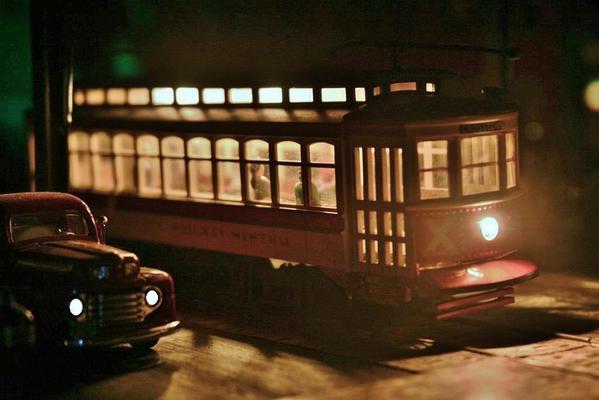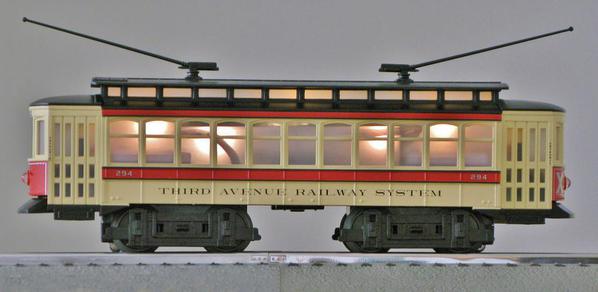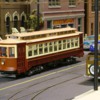Hello Tommy !! --
Well, what you ask would require a small book to really fully answer - but I will try to keep it manageble here !
To answer your questions in order per your numbers :
(1) -- This may take one or two months from initial research to finished operating model; Depending upon my available time. Actual building of, constructing the model usually takes about roughly 100 hours or so approx. from start to finished ready to run product....over a period af a few weeks time....going thru ALL the various processes and multiples of steps outlined further below;
In my case, there is a lot of pre-planning that goes into making a scale model of an O-Scale Rapid Transit Elevated Car (usually a wooden-body vehicle built before WWII) and a "steel" replicated subway car of either pre or post war era. Remember, I produce all such with scale proper full underbody components / details and trucks pertinent to a particular car, body style and series-class, etc., as well as scale prototype replicated interior (seats, route signs, ads, motorman cabs where required, interior bulkheads, etc)
Being I was, among other professional careers, a draftsman (and drew plans, blueprints , etc) long ago, and still do use my skills in such for modeling, and other construction-type-projects I draw a SCALE master plan of the carbody (or structure) I want to construct.
This applied to my earlier HO modeling (1960's-1980's) and likewise to my present O- Scale modeling. I research the proper measurements (width, length, height, etc.,) for the body shell, and the railhead top to floor-line height, from many old tech sources I already have or sometimes have to locate. I also research countless photos depicting the exterior details, interior details and proper underbody components / proper trucks for the car, under construction for needed details info.
I then research my now old Q-Car Co. parts catalogs for the proper interior and underbody details, components, hardware, trucks, etc., required, as most of same usually have been produced and supplied by Q-Car Company thru the past 30 years of my being in O-Scale. Many detail-items I also have to scratch build also for certain cars.
Finally comes the painting of all aspects of the car - after research for the appropriate era-colors. Seats and some interior details, such as motorman cabs, interior bulkheads and etc., are pre-painted BEFORE installation. The interior walls are painted first, and the exterior walls follow. The removable, separate floors, with its pre-installed underbody details, are also painted as one unit.
(2) -- I have variously used smooth surface (no grain or "hairs" ) cardstock of various thicknesses, as well as styrene-sheet stock, and wood as well a "index card" stock, for both carbuilding and details to be fabricated such as motorman cabs, many hand-built seats and supports, interior partitions and bulkheads. Some "steel" pre-war IRT subway cars were built completely with smooth-finish cardstock for the walls, ends, with wood or styrene strips used as hidden interior floorline and roofline reinforcements (called "sills") - and have used 3x5 index card stock to laboriously cut all panels and plates from that material and then hand punched "rivets" into that material. The rivets are carefully counted and lined up on such multiple pre-cut sections, components, as accurate as humanly possible, using scores of old photos of the real cars to ascertain such rivet count numbers and alignment and placement details. These "rivited" panels are then carefully aligned and glued to the cardstock sub-surface main-strength cardstock (or styrene in some cases) walls of the car body. A quite tedious, laborious job for anyone who builds rivited body traction (or any rivited) rail cars !
For Wooden bodied cars (like early EL cars) I used either Evergreen Styrene or Northwestern Scale Wood "Scribed or Batten Board" sheets, with the proper length and height sized exterior siding panels cut out from those sheets. Window posts and their window frames are made assembly line and installed assembly line, one by one.
(3) -- Carbody construction in my shops, usually begins with the "below beltrail" (for pre-war old stock) carbody lower exterior wall siding, whether it being a wood sided car or a simulated steel riveted sided car. Two lower-sides are first made and detailed as needed. Then using a photocopied copy of my "master" scale drawn carbody side drawing plan, I lay the sides on top of the scale photocopy of the carbody side drawing, and then carefully lay out, and install, EACH and ever window post, finishing with the upper body top letterboard panel, whatever, to complete the full sides. I then install the window frame vertical frame strips, and then the horizontal top, bottom and center sash window frame strips. And install any additional exterior details such as door indicator lamps, or as on my 5 IRT EL MUDC converted EL cars, the exterior hung and installed side sliding end doors and upper roller (dummy) assembly covers. I then construct the car end walls and storm doors as 3 separate components, frame them and make a complete one-unit car end for each end of the car.
Once that is done, I spray paint the interior side first, and when dry, paint the exterior side. I generally use spray paint. Some roofs for some of my IRT and BMT Wooden EL cars were provided as "separate epoxy resin body parts" by Q-Car company decades ago as a favor to me, which I paid per-piece for of course then - derived from his (now long discontinued) O-Scale Manhattan EL Open-End-Platform 6-4-6 window body style car production line components long ago produced. These car bodies were cast by Q-Car Co., in separate molds as all separate kit-like parts; ends, sides, roofs, end platforms, etc) and these cast resin body parts then carefully assembled into completed body-shells by (Quentin) Q Car Co. and primed PRIOR to sale as complete body shells. That was the process way back then..
The "Manhattan EL Car" product Roofs I ordered, were then modified where needed (made higher or longer) and clerestory vents changed, replaced, to suit a certain car style.
Quite a number of my subway and EL car roofs are also fully scratch built, following somewhat, the framing and design construction of roofs of the prototype cars. I do have a small few Q-Car Co. Product EL CAR 6-4-6 window car resin body shells that I purchased in the 1984-6 period and finished up to completion. Most other IRT and BMT El car bodies I have were fully scratch built. Of course, again "almost" all finishing details and parts were provided by Q Car Co., for all of them, except those "specialized" details and parts I had to hand create.
(4)-- When I scratchbuilt my nine Q Type EL Cars back in 2001-2, (long before I tech-support-guided MTH to produce their own production run Q-Type EL cars) - and also built my IRT EL MUDC class 5 cars, I did build them as assembly line process.
IE: 5 IRT EL MUDC type Cars needed 10 car body sides, 20 end sliding exterior side doors, ten storm doors, 6 motorman cabs for 3 motor cars, 10 complete Advertising car card strips (all those I custom created myself) for above the window interiors of 5 cars, 2 strips per car; and so on. I assembly-line mass produced each category of components -- IE: all the exterior-side sliding doors were built at once; all door track top cover assemblies, 4 per car, 20 in total, were next done at once; then all 10 storm doors done at once, 10 door indicate lights for 5 cars, 20 "MUDC door control boxes" for 5 cars, 4 per car, and etc., etc.,
Lastly, 10 carbody ends each consisting of a separately built left side and right side end face and its large end window, along with the installed, as previously made, center storm door, so as to be a complete fully assembled carbody "end face" assembly.
And numerous multiples of other repetetive very small details used on each car !
On single one-of-a kind Wooden EL and pre-war replicated-steel subway cars, of course, all window posts and side posts are mass produced at once first, as are the two vertical window frame strips, and top and bottom (and center sash) horizontal window frame pieces. Then installed into the semi-completed car sides with their window posts already previously installed..
ALL subway and EL cars have 1/8" think BASS wood floors cut to fit the bodies.
Of course, my M-o-W work cars (I have quite many) are generally scratchbuilt-made as one specific model each, such as my 3 different style hand built, fully working TA crane cars, my hand built GE50T Diesel Work Loco, some flat cars, and etc.
(5) -- For more dependable and fully trouble free reliable operation, all my cars are built to run on 2-Rail SCALE profile track and operate that way as far as electrical pickup and return (thru all wheels). My "3rd Rail" is patterened after IRT or BMT "elevated" style early uncovered 3rd rail - closer to the track, and a bit higher than subway type 3rd rail. My 3rd rail is wired for either LIVE or DORMANT (dummy) mode with a changeover switch. In "LIVE" mode, the running rails on that track also become both grounded as negative, with the 3rd rail being HOT positive. At some train shows, back in the late 1980's, when the entire huge modular-segment-built EL layout was brought there via a 24 foot box truck, fellow modeler Vern Gillman did operate some of his outside 3rd rail powered O-Scale subway cars on my layout (running on a designated local track on my EL) using the insulated 3rd rail operating shoes fitted on his cars, sliding on and powered by my LIVE 3rd rail. THAT capabiity for shows (and layout visitors who possibly may also have had, built, such operating cars with LIVE 3rd rail shoes) - was why I went to the trouble of setting up my 3rd rails as either Live or Dormant mode. Basically, it was planned for various possible future situations that in reality, other than with Vern's cars at a few shows, actually, heh, never happened again !!
However, my block signals lamp circuits use low voltage AC CURRENT via which some of the connectivity circuitry uses the outside 3rd rails as continuity feeders (instead of, and to save the extra use of, all separate wiring ) for their circuits. Of course, that system has its own On-Off switch and separate small power pack for powering same and the signal system.
(6) -- After all you have read here Tommy, its obvious I would need to produce a BOOK with text and detailed how-to photos to explain the countless details of scale carbody building. Its somehwhat like the training needed to build the real (prototype) things, or build a real house, real airplane, real boat, etc. Then again, I have been at it building models for 55 years (since about 1960), so one has to learn to crawl before they walk and run. And even today, I learn new construction ideas and tidbits here and there from other skilled modelers!! A lot of experimenting, studying, research, and model making skill learning, as ANY skilled scratchbuilder of note here will also tell you, comes first. A few such persons to recall: Steve, aka SIRT; MWB; Terry-CTA Fan; Joe Porretto (subway); Ben Fioriello, NJ HiRailer Club; O-Scale Carl, etc.,
Its like Brain Surgery, you train and learn, study, experiment on donated cadaver bodies in medical schools, for years, before you operate on a live human being's body or, heh, brain !. Not something you do "from the first time get-go" !
It takes an extreme (heh, almost insane? !!)) level of discipline, patience, dedication, drive, TIME and perseverence, to do what has to be done, year after year.
Check my "PHOTO ALBUM SETS" on Flickr of my layout and various types of rolling stock in specific albums
https://www.flickr.com/photos/44268069@N00/sets
PS: PHIL RANDALL -- I will answer your question (#7) by the weekend as I want to take some photos of how it was done - I have to go off line now to go out to eat dinner (11:30PM, heh)
Regards - Joe F
















